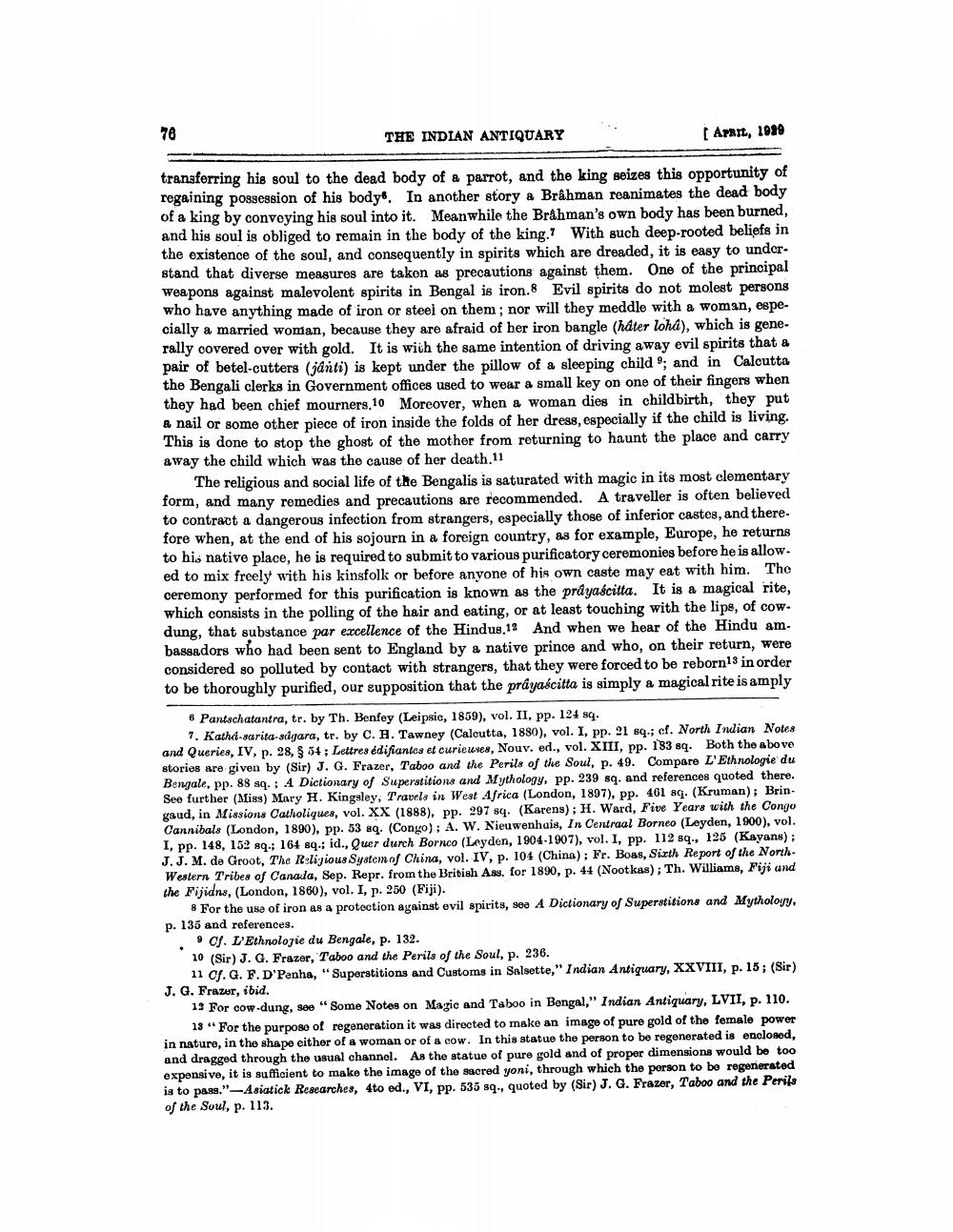________________
THE INDIAN ANTIQUARY
APRIL, 2099
tranaforring his soul to the dead body of a parrot, and the king seizes this opportunity of regaining possession of his body. In another story a Brahman reanimates the dead body of a king by conveying his soul into it. Meanwhile the Brahman's own body has been burned, and his soul is obliged to remain in the body of the king. With such deep-rooted beliefs in the existence of the soul, and consequently in spirits which are dreaded, it is easy to understand that diverse measures are taken as precautions against them. One of the principal Weapons against malevolent spirits in Bengal is iron.8 Evil spirits do not molest persons who have anything made of iron or steel on them; nor will they meddle with a woman, especially a married woman, because they are afraid of her iron bangle (hater lohá), which is gene. rally covered over with gold. It is with the same intention of driving away evil spirits that & pair of betel-cutters (anti) is kept under the pillow of a sleeping child 9; and in Calcutta the Bengali clerks in Government offices used to wear a small key on one of their fingers when they had been chief mourners, 10 Moreover, when a woman dies in childbirth, they put & nail or some other piece of iron inside the folds of her dress, especially if the child is living. This is done to stop the ghost of the mother from returning to haunt the place and carry away the child which was the cause of her death.11
The religious and social life of the Bengalis is saturated with magic in its most elementary form, and many remedies and precautions are recommended. A traveller is often believed to contract a dangerous infection from strangers, especially those of inferior castes, and therefore when, at the end of his sojourn in a foreign country, as for example, Europe, he returns to his native place, he is required to submit to various purificatory ceremonies before he is allow. ed to mix freely with his kinsfolk or before anyone of his own caste may eat with him. The ceremony performed for this purification is known as the prayascitta. It is a magical rite, which consists in the polling of the hair and eating, or at least touching with the lips, of cowdung, that substance par excellence of the Hindus 12 And when we hear of the Hindu am. bassadors who had been sent to England by a native prince and who, on their return, were considered so polluted by contact with strangers, that they were forced to be reborn13 in order to be thoroughly purified, our supposition that the prayascitta is simply a magical rite is amply
& Pantschatantra, tr. by Th. Benfey (Leipsie, 1859), vol. II, pp. 124 sq.
7. Kathd-sarita-scigara, tr. by C. H. Tawney (Calcutta, 1880), vol. I, pp. 21 89.; cf. North Indian Notes and Queries, IV, p. 28, $ 54; Lettres édifiantes et curieuses, Nouv. ed., vol. XIII, pp. 183 sq. Both the above stories are given by (Sir) J. G. Frazer, Taboo and the Perils of the Soul, p. 49. Compare L'Ethnologie du Bengale, pp. 88 sq. ; 4 Dictionary of Superstitions and Mythology, pp. 239 sq. and references quoted there. See further (Miss) Mary H. Kingsley, Travels in West Africa (London, 1897), pp. 461 sq. (Kruman); Bringaud, in Missions Catholiques, vol. XX (1888), pp. 297 sq. (Karens); H. Ward, Five Years with the Congo Cannibals (London, 1890). pp. 53 sq. (Congo): A. W. Nieuwenhuis, in Centraal Borneo (Leyden, 1900), vol. I, pp. 148, 152 sq.; 161 sq.: id., Quer durch Bornco (Leyden, 1904-1907), vol. I, pp. 112 sq., 125 (Kayans); J.J. M. de Groot, The Religious System of China, vol. IV, p. 104 (China); Fr. Boas, Sixth Report of the NorthWestern Tribes of Canada, Sep. Repr. from the British Ass, for 1890, p. 44 (Nootkas); Th. Williams, Fiji and the Fijidns, (London, 1860), vol. I, p. 250 (Fiji).
8 For the use of iron as a protection against evil spirits, see A Dictionary of Superstitions and Mythology, p. 135 and references. . 9 Cf. L'Ethnologie du Bengale, p. 132.
10 (Sir) J. G. Frazer, Taboo and the Perils of the Soul, p. 236.
11 of. G. F. D'Penha, "Superstitions and Customs in Salsette," Indian Antiquary, XXVIII, p. 15; (Sir) J. G. Frazer, ibid.
19 For cow.dung, see "Some Notes on Magic and Taboo in Bongal," Indian Antiquary, LVII, p. 110.
13 "For the purpose of regeneration it was directed to make an image of pure gold of the female power in nature, in the shape either of a woman or of a cow. In this statue the person to be regenerated is enclosed, and dragged through the usual channel. As the statue of pure gold and of proper dimensions would be too expensive, it is sufficient to make the image of the sacred yoni, through which the person to be regenerated is to pass." -Asiatick Researches, 4to od., VI, pp. 535 sq., quoted by (Sir) J. G. Frazer, Taboo and the Perife of the Soul, p. 113.




